top of page

FURNITURE

Berlin writing cabinet
signed Johan Frantz Miller, 1771
The writing cabinet with two drawers bears an adhesive label with the inscription 'Johann Frantz Miller Anno 1771, May 25 in Berlin' and is therefore a rare example of signed Berlin furniture from the second half of the 18th century.
It can be assumed that the piece of furniture is Miller's masterpiece, as it corresponds very closely to the design drawing executed by master cabinetmaker Hager in 1768, which was required by the Berlin cabinetmakers' guild to obtain the title of master craftsman.
The writing cabinet is one of the few surviving masterpieces. Hager's design drawing and the high perfection of the construction of our piece of furniture, as well as the very high-quality selection of the veneer patterns, speak for a masterpiece.
Walnut, walnut burl, maple, rosewood, fire-gilt brass fittings
Height: 230 cm, width: 132 cm, depth: 72 cm
The writing cabinet with two drawers bears an adhesive label with the inscription 'Johann Frantz Miller Anno 1771, May 25 in Berlin' and is therefore a rare example of signed Berlin furniture from the second half of the 18th century.
It can be assumed that the piece of furniture is Miller's masterpiece, as it corresponds very closely to the design drawing executed by master cabinetmaker Hager in 1768, which was required by the Berlin cabinetmakers' guild to obtain the title of master craftsman.
The writing cabinet is one of the few surviving masterpieces. Hager's design drawing and the high perfection of the construction of our piece of furniture, as well as the very high-quality selection of the veneer patterns, speak for a masterpiece.
Walnut, walnut burl, maple, rosewood, fire-gilt brass fittings
Height: 230 cm, width: 132 cm, depth: 72 cm
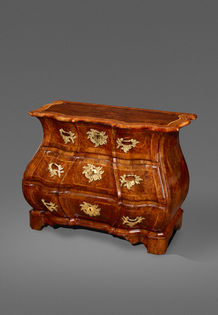
Small baroque chest of drawers
Berlin or Potsdam, around 1750
Chest of drawers with three drawers and all-side cambered body veneered on softwood, walnut, burlwood, and maple, with powerful bronze fittings, its original fire gilding, and a curved top.
Height: 81 cm, width: 103 cm, depth: 57 cm;
Chest of drawers with three drawers and all-side cambered body veneered on softwood, walnut, burlwood, and maple, with powerful bronze fittings, its original fire gilding, and a curved top.
Height: 81 cm, width: 103 cm, depth: 57 cm;
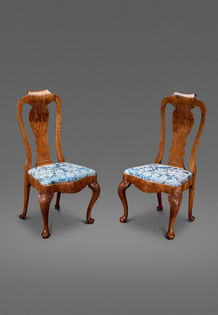
Pair of Neuwied Baroque chairs
Abraham Roentgen workshop, Neuwied, around 1745/55
Walnut, solid, veneered, and upholstered.
The chairs correspond in their character to the earliest phase of Abraham Roentgen's work and are oriented to the English style of the Queen Anne period: the slanted legs stand on cudgel-shaped feet with flat carvings on the knee, the wooden nails of the rear legs which are mortised to the frame remain visible, and the backrest with curved backrest board is rolled backwards.
Height: 110 cm, width 53 cm, seat height 48 cm
Cf. Dietrich Fabian, “Roentgenmöbel aus Neuwied”, Bad Neustadt 1986, p. 249 ff., pic. 589 and 596
Walnut, solid, veneered, and upholstered.
The chairs correspond in their character to the earliest phase of Abraham Roentgen's work and are oriented to the English style of the Queen Anne period: the slanted legs stand on cudgel-shaped feet with flat carvings on the knee, the wooden nails of the rear legs which are mortised to the frame remain visible, and the backrest with curved backrest board is rolled backwards.
Height: 110 cm, width 53 cm, seat height 48 cm
Cf. Dietrich Fabian, “Roentgenmöbel aus Neuwied”, Bad Neustadt 1986, p. 249 ff., pic. 589 and 596

Biedermeier secretary
probably Weimar, Thuringia, around 1820
A secretary “à abattant” elaborately decorated with black stain painting, with three large drawers in the base, and a pull-out writing surface. The central storage opening is architecturally structured and there is a porcelain plaque with an antique scene in the tympanum, white on a wedge-wood blue background. The furniture has various secret compartments.
On oak, mahogany cherry, boxwood partially coloured and veneered. Mother-of-pearl key plates and horn knobs.
Height: 196 cm, width: 108 cm, depth 51 cm/101 cm
A secretary “à abattant” elaborately decorated with black stain painting, with three large drawers in the base, and a pull-out writing surface. The central storage opening is architecturally structured and there is a porcelain plaque with an antique scene in the tympanum, white on a wedge-wood blue background. The furniture has various secret compartments.
On oak, mahogany cherry, boxwood partially coloured and veneered. Mother-of-pearl key plates and horn knobs.
Height: 196 cm, width: 108 cm, depth 51 cm/101 cm
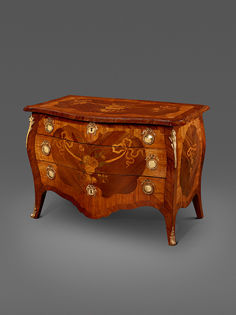
Courtly Rococo chest of drawers
Workshop of the Spindler brothers, Potsdam, around 1765
Chest with three drawers with an all-side slightly cambered body, veneered in mahogany, kingwood, maple and rosewood with remnants of the original coloration, and fittings with remnants of the original fire gilding.
The chest of drawers displays numerous features of the Spindler workshop in the Potsdam period: The top panel, front and sides are masterfully veneered with large floral bouquets in curved cartouches held by bow ties. While the shape of the body and the veneer pattern are still Baroque, the fittings already point to the Louis XVI style.
Johann Friedrich Spindler (1726 - approx. 1799) and his younger brother Heinrich Wilhelm (1738-1788) had fulfilled numerous commissions for furniture and room furnishings for the New Palace and the Hermitage until the death of Margravine Wilhelmine of Bayreuth in 1758. After the death of his favourite sister, Frederick II of Prussia summoned the brothers to Potsdam in 1765. There, after the victorious end of the Seven Years' War, they were to work on the interior design and furnishing of the New Palace.
Height 80 cm, width 114 cm, depth 68 cm
Chest with three drawers with an all-side slightly cambered body, veneered in mahogany, kingwood, maple and rosewood with remnants of the original coloration, and fittings with remnants of the original fire gilding.
The chest of drawers displays numerous features of the Spindler workshop in the Potsdam period: The top panel, front and sides are masterfully veneered with large floral bouquets in curved cartouches held by bow ties. While the shape of the body and the veneer pattern are still Baroque, the fittings already point to the Louis XVI style.
Johann Friedrich Spindler (1726 - approx. 1799) and his younger brother Heinrich Wilhelm (1738-1788) had fulfilled numerous commissions for furniture and room furnishings for the New Palace and the Hermitage until the death of Margravine Wilhelmine of Bayreuth in 1758. After the death of his favourite sister, Frederick II of Prussia summoned the brothers to Potsdam in 1765. There, after the victorious end of the Seven Years' War, they were to work on the interior design and furnishing of the New Palace.
Height 80 cm, width 114 cm, depth 68 cm
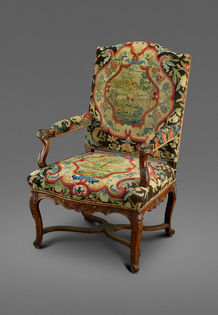
Large armchair
with its original embroidered panel cover
Régence, Paris, around 1720
Armchair, walnut, richly carved, with its original cover in wool and silk, in gros-point and petit-point embroidery.
Height: 113 cm, width: 70 cm, seat depth: 56 cm
Régence, Paris, around 1720
Armchair, walnut, richly carved, with its original cover in wool and silk, in gros-point and petit-point embroidery.
Height: 113 cm, width: 70 cm, seat depth: 56 cm

Signed French Rococo commode
François Mondon (1694-1770, master around 1730), Paris, around 1750
Chest with two drawers on high legs, stamped MONDON JME, rosewood and kingwood veneer, the maple and boxwood inlays are partly engraved, coloured or fire-shaded, with a marble top from the period.
The delicate body with the accentuated corner racks is extraordinarily richly decorated. The front and sides are adorned with floral cartouches, complemented by high-quality, fire-gilt fittings.
Height: 88 cm, width: 62 cm, depth: 50 cm
Cf.: Pierre Kjellberg, “Le Mobilier Français du XVIIIe Siècle. Dictionnaire des Ebenistes et des Menuisiers”, Paris 1989, p 583 f.
Chest with two drawers on high legs, stamped MONDON JME, rosewood and kingwood veneer, the maple and boxwood inlays are partly engraved, coloured or fire-shaded, with a marble top from the period.
The delicate body with the accentuated corner racks is extraordinarily richly decorated. The front and sides are adorned with floral cartouches, complemented by high-quality, fire-gilt fittings.
Height: 88 cm, width: 62 cm, depth: 50 cm
Cf.: Pierre Kjellberg, “Le Mobilier Français du XVIIIe Siècle. Dictionnaire des Ebenistes et des Menuisiers”, Paris 1989, p 583 f.
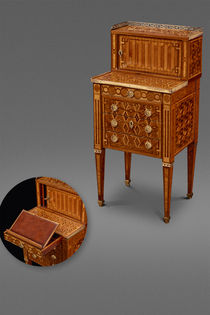
Signed small ladies’ desk “Bonheur-du-Jour”
Pierre Denizot (1715-1782, master since August 1st, 1740), Paris, around 1775
Small salon piece of furniture stamped P・DENIZOT, with marquetry in varying woods, and original bronzes with remnants of old fire gilding.
Elaborately ornamentally marquetry-marked, sophisticated transformable piece of furniture with four drawers and top: the top drawer conceals a hinged and swivel-mounted reading desk, the top with roll-top closure.
This delicate piece of ladies' writing furniture with top and storage compartments was introduced by the Parisian Marchands-Merciers from 1760 under the name Bonheur-du-Jour and became one of the most popular pieces of furniture of the century: light, versatile, versatile, elegant and surprising.
Height: 92 cm, width: 44 cm, depth: 38 cm
Small salon piece of furniture stamped P・DENIZOT, with marquetry in varying woods, and original bronzes with remnants of old fire gilding.
Elaborately ornamentally marquetry-marked, sophisticated transformable piece of furniture with four drawers and top: the top drawer conceals a hinged and swivel-mounted reading desk, the top with roll-top closure.
This delicate piece of ladies' writing furniture with top and storage compartments was introduced by the Parisian Marchands-Merciers from 1760 under the name Bonheur-du-Jour and became one of the most popular pieces of furniture of the century: light, versatile, versatile, elegant and surprising.
Height: 92 cm, width: 44 cm, depth: 38 cm
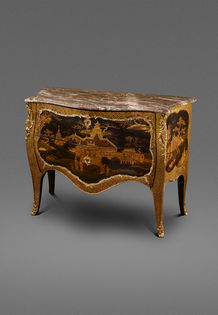
Important Parisian lacquer commode
Jacques Dubois (1693-1763, master since 1742), Paris, around 1750
Stamped JDUBOIS, Vernis Martin with Chinese depictions, original fire-gilt bronze mounts and its original marble top.
On all three sides of the chest with two drawers with very well-preserved depictions of generous Chinese garden architecture in a hilly landscape with figural staffage, and the black-ground cartouches contrasting with the framing with a golden lattice pattern.
Height: 91 cm, width: 122 cm, depth: 56 cm
Stamped JDUBOIS, Vernis Martin with Chinese depictions, original fire-gilt bronze mounts and its original marble top.
On all three sides of the chest with two drawers with very well-preserved depictions of generous Chinese garden architecture in a hilly landscape with figural staffage, and the black-ground cartouches contrasting with the framing with a golden lattice pattern.
Height: 91 cm, width: 122 cm, depth: 56 cm

Large Louis XV chest of drawers, cambered on all sides
Jacques Philippe Carel, master since 1723, Paris, around 1750
Veneered on oak, royal wood, and rosewood, partly coloured, engraved, and fire-shaded, with its original fire-gilt fittings, and a plate of Breche d'Alep marble.
Works by Carel can be found in the Munich Residence, the Palace of Versailles, the Louvre in Paris, and the Carnavalet museum in Paris
Height: 90 cm, width: 148, depth: 65 cm
Veneered on oak, royal wood, and rosewood, partly coloured, engraved, and fire-shaded, with its original fire-gilt fittings, and a plate of Breche d'Alep marble.
Works by Carel can be found in the Munich Residence, the Palace of Versailles, the Louvre in Paris, and the Carnavalet museum in Paris
Height: 90 cm, width: 148, depth: 65 cm
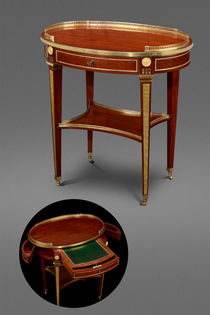
Classicist working table
David Roentgen, Neuwied 1785-90
Working table in mahogany, solid and veneered, with brass galleries, rosettes, and mouldings.
Oval transforming table with shelf, the central drawer under the top conceals a leather-covered writing surface, which triggers the mechanism of drawers that spring open at the sides when pulled out. The top must be moved backwards to make the work surface usable and the legs must be unscrewed, as with many pieces of furniture from the Roentgen workshop in Neuwied, which were stowed away in the most space-saving and careful way for the enormously long distribution routes throughout Europe and as far as Russia.
An identical table has been preserved in Schloss Fasanerie near Fulda from the estate of the Landgraves of Hesse-Kassel: Philippine von Brandenburg-Schwedt (1745-1800), the second wife of Frederick II of Hesse-Kassel, owned numerous pieces of furniture and clocks from David Roentgen's workshop.
Height: 76 cm, width: 72 cm, depth: 50 cm
Cf: Exhib. Cat. Schloss Fasanerie 2019, “Die Möbel der Mächtigen. Meisterwerke der Schreinerkunst und ihre Besitzer”
Cf: Wolfram Koeppe, “Extravagant Inventions: The Princely Furniture of the Roentgens, New Haven and London” 2012, p. 180
Cf.: Dietrich Fabian, “Roentgenmöbel aus Neuwied, Bad Neustadt” 1986, p. 85, pic. 160
Working table in mahogany, solid and veneered, with brass galleries, rosettes, and mouldings.
Oval transforming table with shelf, the central drawer under the top conceals a leather-covered writing surface, which triggers the mechanism of drawers that spring open at the sides when pulled out. The top must be moved backwards to make the work surface usable and the legs must be unscrewed, as with many pieces of furniture from the Roentgen workshop in Neuwied, which were stowed away in the most space-saving and careful way for the enormously long distribution routes throughout Europe and as far as Russia.
An identical table has been preserved in Schloss Fasanerie near Fulda from the estate of the Landgraves of Hesse-Kassel: Philippine von Brandenburg-Schwedt (1745-1800), the second wife of Frederick II of Hesse-Kassel, owned numerous pieces of furniture and clocks from David Roentgen's workshop.
Height: 76 cm, width: 72 cm, depth: 50 cm
Cf: Exhib. Cat. Schloss Fasanerie 2019, “Die Möbel der Mächtigen. Meisterwerke der Schreinerkunst und ihre Besitzer”
Cf: Wolfram Koeppe, “Extravagant Inventions: The Princely Furniture of the Roentgens, New Haven and London” 2012, p. 180
Cf.: Dietrich Fabian, “Roentgenmöbel aus Neuwied, Bad Neustadt” 1986, p. 85, pic. 160
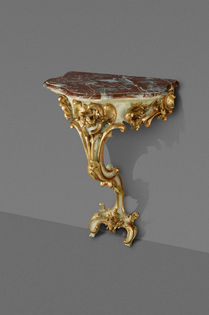
Franconian Rococo console
Bayreuth, around 1765
Carved softwood painted white and gold on a red bolus and chalk ground, with its original red and white marble top.
Height: 86 cm, width: 61 cm, depth: 44 cm
Cf. Heinrich Kreisel, Hans Kuhn and Georg Himmelheber, “Die Kunst des deutschen Möbels”, 3 vols. Munich 1970, vol. II, p. 217, pic. 704
Carved softwood painted white and gold on a red bolus and chalk ground, with its original red and white marble top.
Height: 86 cm, width: 61 cm, depth: 44 cm
Cf. Heinrich Kreisel, Hans Kuhn and Georg Himmelheber, “Die Kunst des deutschen Möbels”, 3 vols. Munich 1970, vol. II, p. 217, pic. 704

Elegant pair of free-standing etageres
Northern Italy, probably Milan, around 1815
Walnut, solid and veneered, with drawers in the socles.
Height: 150 cm, width: 60 cm, depth: 40 cm
Walnut, solid and veneered, with drawers in the socles.
Height: 150 cm, width: 60 cm, depth: 40 cm
bottom of page
